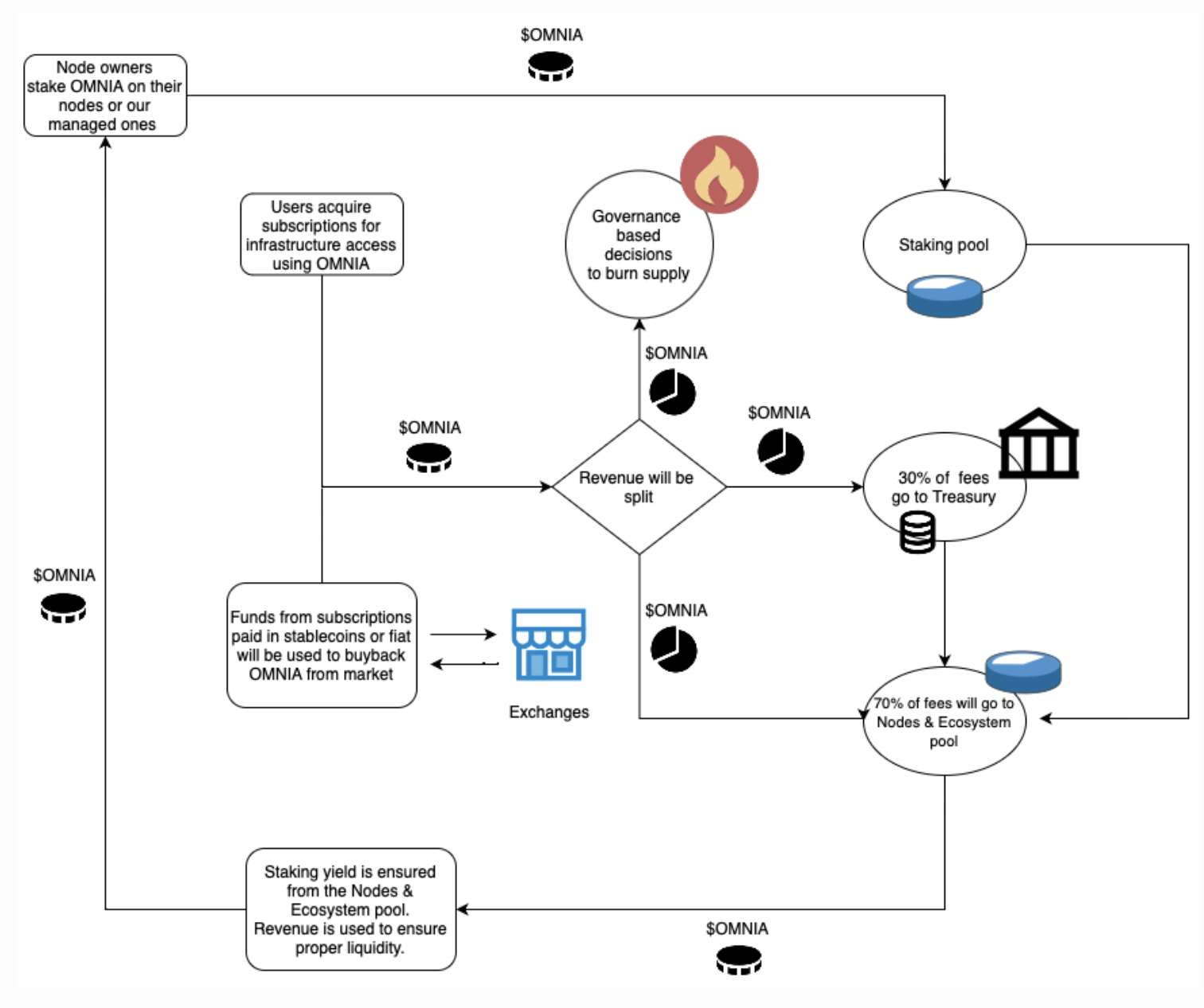OMNIA Protocol is a security-focused, decentralized infrastructure designed to ensure secure and private blockchain transactions. It supports various web3 and DApp ecosystems by offering security-centric solutions that protect transactions without compromising network performance. This article highlights different aspects of the OMNIA Protocol, its modus operandi, and the much-anticipated $OMNIA token launch.
KEY TAKEAWAYS
➤ OMNIA Protocol uses DePIN technology to provide security-focused infrastructure solutions for web3 apps.
➤ The platform’s native $OMNIA token serves dual purposes as both a utility and governance token.
➤ The $OMNIA Initial DEX Offering (IDO) will take place on the ChainGPT Pad platform and grants investors early access to the OMNIA ecosystem.
What is OMNIA Protocol?
Put simply, OMNIA Protocol is a decentralized infrastructure that aims to provide secure and private access to blockchain networks.
The majority of current blockchain access is centralized, with just a few major providers like Infura handling most DApp requests. This centralization poses several risks, such as network outages, exploitation of user metadata, and increased vulnerability to attacks.
For instance, a bug in a centralized Ethereum node provider in November 2020 led to a widespread network outage, affecting exchanges and wallet providers.
OMNIA addresses the issue of centralization in existing node provider services by leveraging a distributed network of independent nodes. This approach ensures that no single entity has control over blockchain data while eliminating the risk of service disruptions.
Users and organizations can participate in securing the network by operating nodes and earn rewards in return.
This approach reduces centralization, mitigates risks, and ensures that users maintain control over their data, thereby creating a more resilient and private infrastructure for web3 applications.
OMNIA Protocol was co-founded in 2021 by CEO Cristian Lupascu and CTO Alexandru Lupascu. Listed advisors include ex-Kraken Managing Director Tal Cohen and Ilan Rakhamov, CEO and founder of ChainGPT.
The protocol has partnerships with a number of big names across web3 and web3, including Microsoft, Google, AWS, Chainalysis, and Cloudflare.
Key traits of OMNIA Protocol
- Security-centric design: OMNIA Protocol uses a decentralized network of nodes and node verification protocols to protect user data and maintain security without revealing sensitive information.
- Decentralized infrastructure: OMNIA nodes operate independently to distribute network tasks and eliminate single points of failure.
- Incentivized participation: Node operators are rewarded with $OMNIA tokens, which creates a sustainable model that encourages more participants to join the network.
- Access to multiple blockchains: OMNIA supports more than 70 blockchains, including Ethereum and Binance Smart Chain.
How does OMNIA Protocol work?
OMNIA Protocol functions as a decentralized relay network where OMNIA nodes handle all requests to ensure complete privacy and security. These nodes distribute transaction requests and ensure that no single entity can monopolize access to a blockchain network.
Each node operates independently and processes transactions using advanced security tools, which validate integrity without revealing any underlying data.
This setup enables users to interact with blockchain networks securely. Their assets and transactions are protected from hacks or exploitation.
OMNIA also simplifies the setup and maintenance of nodes so that more participants can join and contribute to the network’s security.
This comprehensive functionality allows developers to build on OMNIA’s platform with enhanced capabilities. It also ensures that web3 applications can operate securely and efficiently without relying on centralized infrastructure.
Additionally, the protocol leverages Maximum Extractable Value (MEV) strategies to capture value from arbitrage opportunities within blockchain transactions. This way, OMNIA can monetize its infrastructure without compromising user mempool privacy. Among other perks, it also helps create a sustainable model for incentivizing node operators and rewarding network participants.
All these aspects combine to promise a highly resilient infrastructure capable of supporting various blockchain networks like Ethereum, BNB Smart Chain, and more.
$OMNIA token overview
The $OMNIA token plays a critical role in the ecosystem by serving as both a utility and governance token.
Token holders can stake $OMNIA to secure the network, access premium features, and vote on protocol decisions. Users can also unlock benefits like faster RPC nodes, private blockchain endpoints, and exclusive governance rights by holding and staking $OMNIA.
The token also incentivizes node operators who earn rewards for supporting the network’s infrastructure. This model aligns the interests of the community and ensures that the protocol remains decentralized and community-driven.
In a nutshell:
➤ $OMNIA offers access to premium services like private RPC nodes and enhanced security features.
➤ It grants voting rights on key protocol updates, network fees, and future development.
➤ Users earn rewards for staking $OMNIA and contributing to the network’s governance and security.

Upcoming $OMNIA IDO details
The $OMNIA Initial DEX Offering (IDO) will take place on the ChainGPT Pad platform on Oct. 14, 2024. It aims to raise $700,000 with a total of 2,000,000 $OMNIA tokens made available at $0.35 USDT per token.
The IDO provides early access to investors interested in participating in the growth of the OMNIA ecosystem. After the IDO, tokens will be subject to a vesting schedule, with 15% released at the Token Generation Event (TGE), a one-month cliff, and the remaining tokens vested linearly over eight months.
Key IDO information:
- Initial market cap (IMC): $235,000 (excluding liquidity).
- Fully diluted valuation (FDV): $35,000,000.
- Accepted currency: USDT.
- Token claim network: BNB Smart Chain.
This IDO marks a significant milestone for OMNIA as it will enable the platform to scale its infrastructure and attract more node operators. Investors participating in the IDO will gain early access to the protocol’s ecosystem and its suite of security-focused solutions for web3 applications.
DePIN: Decentralized Physical Infrastructure Networks

OMNIA Protocol’s integration of DePIN is a major differentiator from traditional centralized node providers.
DePIN involves decentralizing not just the digital components of a network (such as nodes) but also the physical infrastructure (such as servers and data centers) that support it. This creates a more reliable and scalable network, as resources are spread across numerous independent operators rather than centralized in a few data centers.
To cut a long story short, the integration of DePIN strengthens network resilience and privacy while enabling smooth interactions between multiple blockchain ecosystems.
OMNIA’s node infrastructure
Becoming a node operator on the OMNIA Protocol is relatively straightforward. While the platform aims to simplify the process with a user-friendly interface, operators still need to understand blockchain infrastructure, install compatible software, and configure nodes correctly.
This knowledge is essential for ensuring that nodes perform optimally and meet the protocol’s security and performance standards. Here’s what to know about becoming a node operator:
Hardware and software requirements
Node operators must meet certain hardware and software requirements to ensure they can handle network traffic efficiently. For instance, a minimum hardware specification could include a multi-core CPU, SSD storage, and a stable internet connection with low latency.
Operators should install the necessary blockchain client software that is compatible with the networks they wish to support. For instance, if supporting Ethereum, they must run an Ethereum client such as Geth or OpenEthereum.
Node registration
Prospective node operators start by registering their nodes. The registration process requires details such as node specifications, location, and network type.
After registration, the protocol indexes the nodes and makes them available to relayers. Relayers play a key role in directing traffic to these nodes based on their performance, location, and security parameters.
Node verification and security protocols
After registration, nodes are subjected to a verification process that ensures compliance with OMNIA’s security standards. The protocol uses cryptographic methods to validate the integrity and reliability of the nodes.
As part of this system, OMNIA implements a staking mechanism where node operators must stake $OMNIA tokens to guarantee their commitment to the network.
This stake can be slashed (i.e., partially or fully forfeited) if a node acts maliciously or fails to meet performance criteria. This economic disincentive ensures that operators maintain high standards of service.
Node utilization and relayer coordination
OMNIA’s relayers coordinate the utilization of nodes by routing requests to those that best meet the current network demands. For instance, if a node has low latency and high throughput, it will receive a higher share of traffic.
Operators can choose which blockchains they want their nodes to support, such as Ethereum, BNB Smart Chain, or other compatible networks. The more networks a node supports, the more rewards it can potentially earn.
Subscription and access model
Users interacting with the protocol can choose from various subscription plans as per their specific requirements. These plans determine the number of requests per second (RPS) and access to premium features like private RPC endpoints.
Each subscription plan can be discounted using $OMNIA tokens, which allows users to access secure RPC nodes for supported blockchain networks. Node operators, in turn, earn rewards based on staking collateral.
Incentives for node operators
Node operators earn rewards in $OMNIA tokens for their contributions. The amount of rewards depends on factors like the node’s uptime, reliability, performance and volume of transactions processed.
Operators can also participate in OMNIA’s governance process, using their staked $OMNIA tokens to vote on network upgrades, protocol changes, and community proposals.
Node health monitoring
OMNIA provides various tools for node operators to monitor their node’s health, performance, and security in real time. The platform also releases regular updates to patch vulnerabilities and bugs while ensuring compatibility with the latest protocol versions.
Operators can customize their node’s configuration to optimize for specific use cases, such as handling high-frequency trading transactions or supporting complex smart contracts.
OMNIA’s business model and monetization strategy
OMNIA’s business model revolves around providing secure and private access to blockchain networks through a SaaS-based subscription model. The protocol’s revenue streams include RPC APIs, compliant MEV monetization, and commission-based aggregation services.
This diversified approach allows OMNIA to maintain its security guarantees while generating sustainable revenue.
The protocol also plans to implement a unique referral and reward system to drive user growth. This growth strategy is complemented by influencer marketing and community engagement initiatives.
Roadmap and future developments
OMNIA Protocol has outlined a detailed roadmap for development through 2025 by targeting key areas to enhance its infrastructure and expand capabilities.
For 2024, OMNIA plans to add support for more blockchain networks and implement features like request batching. This will optimize transaction processing and introduce private mempools to allow for efficient multi-chain transactions.
OMNIA Protocol and blockchain security
Overall, OMNIA Protocol appears to be steadily on the way to providing the necessary tools for creating a highly secure blockchain ecosystem. So far, the protocol has maintained a neat track record by progressively strengthening blockchain privacy with anonymous transactions and securely stored user data.
If it sticks to the roadmap it has outlined, OMNIA could soon further cement its position as a go-to solution for security-focused web3 and DApp projects.
Disclaimer: This article is to inform and educate and is not investment advice. Crypto is a volatile asset and investing in decentralized assets carries risk.

